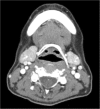Preliminary study on the efficacy of xerostomia treatment with sialocentesis targeting thyroid disease patients given radioiodine therapy
- PMID: 31544098
- PMCID: PMC6728110
- DOI: 10.1186/s40902-019-0223-3
Preliminary study on the efficacy of xerostomia treatment with sialocentesis targeting thyroid disease patients given radioiodine therapy
Abstract
Background: Radioiodine therapy has been widely used for thyroid disease patients, but hyposalivation and xerostomia may occur in 10~30% of patients. Sialocentesis is a procedure that removes inflammatory substances in the salivary duct and expands the duct for the secretion and delivery of saliva. In this study, thyroid disease patients treated with radioactive iodine were selected among the patients with xerostomia who visited the hospital, and the effect of sialocentesis was compared and analyzed. And then, comparison between the radioiodine therapy-experienced group and the non-radioiodine therapy-experienced group was conducted.
Results: In this study, we studied xerostomia patients who underwent radioiodine therapy due to thyroid diseases and who underwent sialocentesis at the Korea University Anam Hospital. Sialocentesis is conducted by one surgeon. The study also compares the clinical symptoms before and after the surgery. After the procedure, the discomfort due to xerostomia was reduced, and the symptom was improved effectively.
Conclusions: The results of this study showed that sialocentesis has a clinical effect in the treatment of xerostomia, which is a side effect of radioiodine therapy. In addition, the possibility of further clinical application of sialocentesis in the future is found.
Keywords: Radioiodine; Sialendoscopy; Sialocentesis; Submandibular gland; Xerostomia.
Conflict of interest statement
Competing interestsThe authors declare that they have no competing interests.
Figures
Similar articles
-
Effects of Radioiodine Treatment on Salivary Gland Function in Patients with Differentiated Thyroid Carcinoma: A Prospective Study.J Nucl Med. 2016 Nov;57(11):1685-1691. doi: 10.2967/jnumed.115.169888. Epub 2016 Jun 23. J Nucl Med. 2016. PMID: 27339871 Clinical Trial.
-
Sialolithotomy of the submandibular duct using sialendoscopy.Maxillofac Plast Reconstr Surg. 2019 Jun 24;41(1):24. doi: 10.1186/s40902-019-0207-3. eCollection 2019 Dec. Maxillofac Plast Reconstr Surg. 2019. PMID: 31297364 Free PMC article.
-
Impact of sialendoscopy on improving health related quality of life in patients suffering from radioiodineinduced xerostomia.Nuklearmedizin. 2018 Aug;57(4):160-167. doi: 10.3413/Nukmed-0964-18-03. Epub 2018 Aug 20. Nuklearmedizin. 2018. PMID: 30125928 English.
-
Interventional sialendoscopy for radioiodine-induced sialadenitis: quo vadis?Acta Otorhinolaryngol Ital. 2017 Apr;37(2):155-159. doi: 10.14639/0392-100X-1606. Acta Otorhinolaryngol Ital. 2017. PMID: 28516979 Free PMC article. Review.
-
Role of radioactive iodine for adjuvant therapy and treatment of metastases.J Natl Compr Canc Netw. 2007 Jul;5(6):631-40. doi: 10.6004/jnccn.2007.0054. J Natl Compr Canc Netw. 2007. PMID: 17623614 Review.
Cited by
-
Therapeutic effects of sialendoscopy for diagnosis and treatment of hyposalivation patients: a retrospective study.Maxillofac Plast Reconstr Surg. 2022 Oct 24;44(1):34. doi: 10.1186/s40902-022-00360-8. Maxillofac Plast Reconstr Surg. 2022. PMID: 36279018 Free PMC article.
References
-
- Rigler R, Scanlon P (1955) Radiation parotitis from radioactive iodine therapy. In: Proceedings of the staff meetings. Mayo Clinic - PubMed
-
- Solans R, Bosch J-A, Galofré P, Porta F, Roselló J, Selva-O’Callagan A, et al. Salivary and lacrimal gland dysfunction (sicca syndrome) after radioiodine therapy. J Nuclear Med. 2001;42(5):738–743. - PubMed
LinkOut - more resources
Full Text Sources






